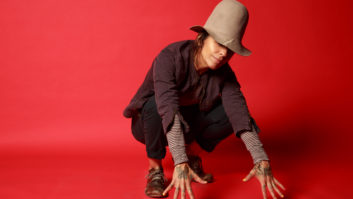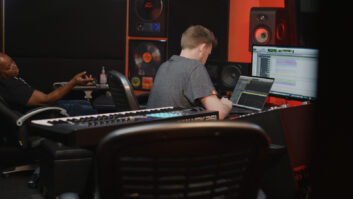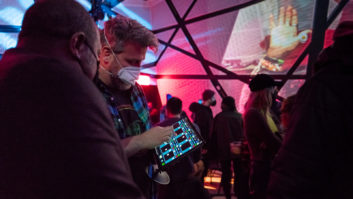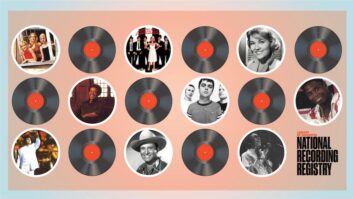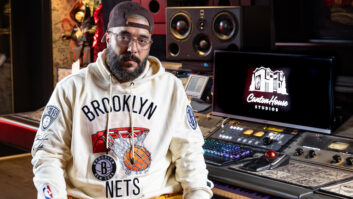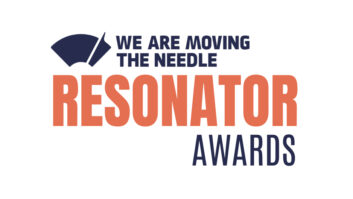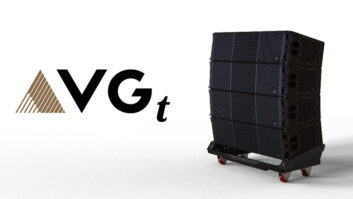Dynamo pretty much sums up Linda Perry. Maybe superwoman. Self-professed music addict. She’s a producer (last year becoming the first female in 15 years to be nominated by NARAS for Producer of the Year) and engineer, and she’s in the songwriting Hall of Fame, having helped to launch Pink’s career and written songs for and with such luminaries as Christina Aguilera, Britney Spears, Adele, Alicia Keys and Dolly Parton, among countless others. She doesn’t sleep much.
Recently, Perry and her business partner, producer Kerry Brown, opened up what she calls “offices” on Ventura Blvd. in the San Fernando Valley. Actually, it’s a music complex dubbed We Are Hear, a combination record label, publishing house, management company and production space.
During our conversation she recalled that her wife, Sara Gilbert, asked her at one point in the not too distant past what she was doing now that artists and art seemed pretty stagnant. Perry answered: “When people want music and songs, my phone will start ringing. I’m going to keep myself busy by being a leader, not a follower, which is what I’ve spent time doing. And now my phone is ringing a lot. I guess people want songs again.”
Mix: This is Mix magazine, so let’s jump right in. Is there a studio at We Are Hear?
Linda Perry: We’re building one in the back. We see a lot of kids skating around on the weekends, kind of aimless. There’s not a lot for kids to do over there, so Kerry and I wanted a place on Ventura Boulevard where kids who were interested in music could come in. We’ll sell vinyl and we have posters and merch, and we’re going to set up a little listening post with record players and they can sit there and hang and listen to music.
And then in the back we will have a showcase room and we’ll host songwriter showcases where we will invite kids to come down and play songs. We’ll make an event out of it, and we’ll record them and send them a WAV file of what we recorded. That way they can meet other kids who want to be in bands, because we believe that one of the problems with this generation is that there is a lack of community and that kids aren’t understanding the connections they should have with their bandmates—that’s what made the Stones and Zeppelin and all the greatest bands in the world. They started with a connection and that’s how they created greatness. We’re trying to bring back that community.
But the studio that you record artists in is a separate one, in Sherman Oaks?
Yes. I originally had a big studio in North Hollywood, but it felt like my ego was flaring and I decided to sell it, so I turned a house of mine that I loved that was sitting there and doing nothing into my studio, and it’s amazing. There’s a great vibe there. It’s not a house studio; it just happens to be a studio in a house.
You’re an engineer, as well, I understand. And you have a penchant for analog gear. When did that all start?
When I left 4 Non Blondes, one of the biggest problems I experienced during the process of making the record Bigger, Better, Faster, More! was, in all honesty, I did not like the sound of it whatsoever. It sounded really thin, like there was way too much reverb, too polished and I couldn’t stand my vocals—the whole sound of the record. And this was prior to me understanding that I would become an engineer and producer. All I would do was go back and talk to the producer and say, “Listen, my guitar tone in the live room sounds great, but when I come in here and listen to it, it sounds distant and far.” I was just asking him to tell me what he was doing, but the go-to answer was, “Let me be the producer and you just go be the artist.”
“Shut up and sing.”
Exactly. And I would bump heads with him constantly. And then we would get to the drum sounds and I would say, “They sound so plastic,” and it was a constant battle. Then “What’s Up?” came up to record and I was like, “Oh no, no, no.” This was not flying with me. It had a solo in it, marching drums, and he asked me to change the lyrics and everybody looked at me and said, “Just do what he’s asking you to do.” So I did all of that and we got to the end and I was literally crying. I said, “I don’t know what this song is, but it’s not the song I wrote. I’m going to let all the other songs slide right now, but not this.”
The label said, “This sounds great, we’re happy with it.” The label, mind you, I have come to know, has a completely different story of what happened, but I am telling you the real story. So I took the band and said, “We’re going to re-record this.” We had two days before mastering. No one would give us any more money, so we went off to the Record Plant in Sausalito where they gave us a favor. We had one reel of tape, the band went in there without the producer and I asked the engineer to help.
I started just dialing in sounds with him and moving microphones, getting the drum sounds to make it little bit fatter than what was there. I was asking, “What does this do?” And he’d say, “That’s EQ,” and I’d be tuning knobs. I would say, “That’s the sound, right there,” or “I don’t like the snare,” and he’d ask, “What is it you’re hearing?” And I’d say, “It sounds too thin and I’m hearing too much splat,” and he’d say, “Oh, the bottom snare is too high,” and he’d turn it down and I’d say, “There it is.”
We recorded the song and we had to choose—because, mind you, we only had one reel of tape, and one reel of tape only could have three takes, so we would have to know that we didn’t want a particular take for sure so we could go over it. The producer, David Tickle, shows up around 12 at night, right when we’re getting our take, and I was so bummed out. It was like, “What are you doing here?” And he said, “We’ve got to mix this and get it to mastering in the morning.”
So we get the take we want. I believe I did two vocals and we cut between the two of them. Everything was super fast. We mixed it that night and made it to mastering the next day. And then when I asked for production credit? “Can’t you just be happy that you saved the day?” I said, “Okay.” And right then and there I knew exactly what I was going to be in for. Everything from then on out, I’d better know what I was doing because this is never going to happen again.
Then when I left the band I met Bill Bottrell, and he was my true mentor. I made this record In Flight with him, and he taught me everything. And he showed me everything. He taught me how to be an engineer and how to listen or how not to listen, actually—moreso just how to feel, like if it feels and it sounds good, you’re good.
And the preference for analog gear?
Before I met Bill, I had started buying gear. And this is the funny part—I started buying gear based on how it looked. I had a big warehouse in San Francisco with like 4,700 square feet. I put a stage in there, everything was all lined up, I jammed in there all the time and I built a studio in there all on my own, and then when I met Bill, he gave me the information that I was lacking. When I was at his place, I noticed I had a lot of the stuff he had, so the stuff that I was buying was on instinct.
I have three Fairchild 670s, a 660 and a 666. I bought a bunch of Pultecs because I just love the knobs, and I got a bunch of Neves because I used to go to Coast Recorders all the time. I have four U47 mics, 251s, 270s, and I’m a fan of SM7s.
In my studio, I linked up a 1604 API with my Melbourne 12-channel Neve, so if I want to track on the Neve, I track on the Neve and monitor on the API, or I switch it. Sometimes I’ll run everything through the API and the Neve and then just monitor everything and just mix in the box. I’ll go back and forth. I have a Studer 4-track and an 8-track Tascam that is amazing, and that’s just the gear in my studio. I have a whole warehouse full of gear I don’t use. My babies are my Pultecs and my Fairchilds; those I can’t live without.
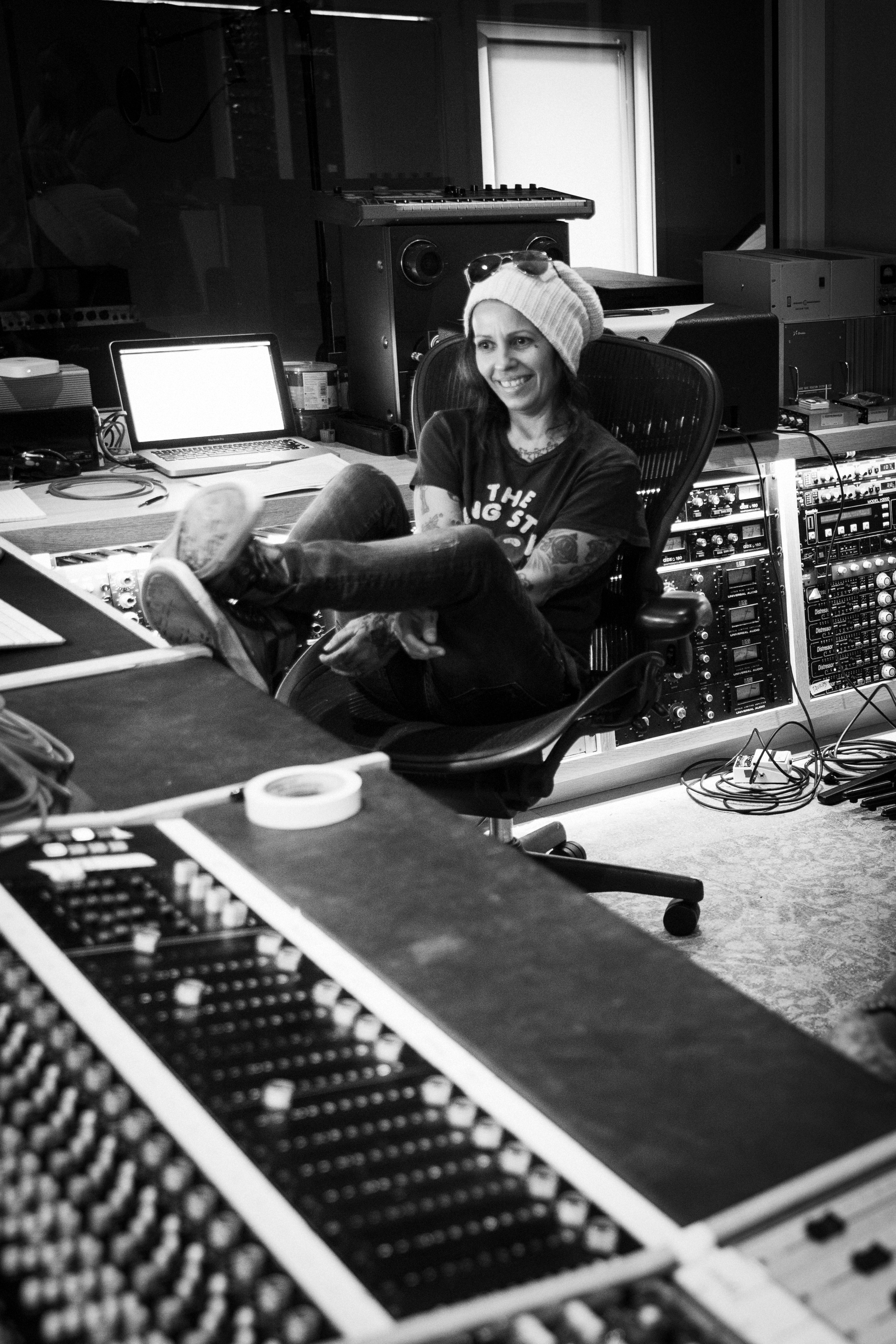
Why it is important for you to engineer and produce when most choose one or the other?
For me it came hand and hand. I was so curious in the process of recording, not just how to capture the emotion and vision of the song, but also how to create the right sounds. I love drums, and a great drum sound starts with the drummer—the way they hit, the way they interpret the song, the way they feel. Then second is the tuning. You need to make sure your drums are tuned properly. Third, it’s using the least amount of mics possible for the song. The most I will ever use is an (Electro-Voice) RE20 inside the kick, a FET 47 outside the kick and 57s on the snare, top and bottom. Sometimes I stick an 87 off to the side to catch the snare more. I’ll put 441s on the rack toms and floor tom, a Coles off to the side of the floor tom and a Coles overhead, as well as a pair of 44s and sometimes a 47 or a sub in the room somewhere.
The least I will use is a 44 on the kick, an 87 three feet from the floor tom and a Coles overhead. I rarely compress drums, but depending on the song I may use a [Fairchild] 670 on room mics and [UREI] 1176 on toms and maybe a Distressor on the snare for extra attack and snap. Sometimes I’ll put the room mics in a 160 and slam them as hard as I can. For EQ I use Pultecs, APIs and Neves. It really depends on the song.
Let’s talk about songwriting. You’ve said you live in a place of dark rock ‘n’ roll, but the thing that put both you and Pink on the map was “Get the Party Started.” Kind of ironic.
It’s more ironic than you know based on what the label wanted from me. But when I finally got out of my deal with Interscope, I moved to L.A. I was listening to the radio and called this hit producer friend of mine and asked him, “What is that sound?” And he said, “Oh, that’s a Triton keyboard and the Roland expansion, and everybody’s doing things on this Pro Tools thing on an MPC,” and I’m like, “Okay,” so I went and bought all that stuff and set it up in my house. Mind you, I’m all analog so I’ve never dealt with these kinds of things before, and now I’m taking everything for a test drive.
So I need a beat, and I come up with this beat and I add all this percussion to it. I pick up a real bass because I couldn’t find a bass tone that was suitable to me. I wasn’t on Pro Tools, so I had to play everything down live, three minutes and 30 seconds, and I just played live all the way down. I go on the Roland and find horn sounds and harpsichord sounds, flutes, and I get the guitar and put it through my wah-wah and there’s this cool, weird, crazy track going on.
Then I think, “Okay, I’m just going to put some vocals on it.” Basically, I was coming at it as an experiment, but also as a joke. I pick up a bullet microphone, a harmonica microphone, and I’m thinking every cliché I can think of, and I just busted into “Get the party started on a Saturday night.” I literally came up with the song in 30 minutes.
I called up my manager and played it for her over the phone, and she said, “What’s that?” And I said, “That’s a hit fucking song for somebody.” She said, “Who are we going to give this to?” I said, “Maybe Madonna. I could hear her doing something like this.” A week later this crazy girl called me up and that’s how the Pink thing happened.
How did she know about you?
She was a fan of 4 Non Blondes. “Dear Mr. President” was a favorite song of hers, so she tracked me down. She wanted me to maybe write a song with her or sing with her on her record. Once we met, I played her “Get the Party Started” and she loved it. She played it for L.A. Reid and he was, like, “Okay, we have your first single.” Then it turned into me producing the bulk of the album and creating this whole new identity for her.
Do you find you work better with the up and comers as opposed to the more established artists?
It’s hard to answer that because I just like to work with people who are honest. That could be a no-name or the most famous person in the world. Unfortunately, sad to say, the people who are more in the forefront are often the last people who want to be honest because they have so much to lose. I find I shine better with people who are willing to risk it all and go left-field and explore the possibilities of what they can be, and that was the beauty of what Alecia [Pink] and I were when we were working together. The reason our connection was so good was we both wanted to explore the possibilities. She is fully responsible for creating herself. She just stumbled upon the right person to do it with, and her instincts were right on to call me. She would never have gotten that with somebody else. I’m always in search of someone who is willing to explore. The people who aren’t willing to do that are people who are afraid of failing.
Right now I’m only focusing on new artists with We Are Hear. Kerry and I have had so many conversations about artists and labels and the music business and how nobody is taking risks, how everybody is basing their careers on fear. That energy doesn’t belong in the music business. The music business is based on fearlessness; going outside the box, going into the studio and exploring the possibilities of what a song can become. People say I’m not relevant and haven’t done anything in a while, but I haven’t done anything in a while because I haven’t wanted to; there’s been no one to do it with. Now I’ve found that by starting this label, I have the opportunity to explore with our artists like Dorothy or Willa Amai. I just finished an incredible record with Natasha Bedingfield.
She’s not exactly a new artist.
But she is because she’s all about risk right now. She’s been in the business for a while, but she discovered the people around her were making wrong decisions. So she got out of her deal because she felt like she couldn’t do anything different with her label. She went and had a baby and came back to me and said, “Let’s do something.” What Dolly Parton and I created was super fucking cool. We took old songs of hers and made them modern.
And then you brought together Dolly—an established artist—with up-and-comer Willa Amai, and changed the arrangement of an iconic tune.
Yes and also wrote great songs that stood up strong to the classics. So to answer your question, I’m best at probably reinventing someone and helping a newcomer with their vision. I’m not good at, “I want a pop song that hits on the radio and I want it to sound like everybody else.” I’m not that girl.
How did you know music was your muse?
I never made a choice. It was handed to me from the day I was born, it was just in me. It came with me like walking and talking. I just didn’t understand it was my career
What did you love?
I was listening to everything. My sister listened to the Beach Boys and Elvis Presley, my mom loved Carmen Miranda and Sergio Mendes, and my father listened to Frank Sinatra, Cole Porter and any kind of jazz music, and my brothers listened to the Monkees, the Beatles, the Turtles. I gravitated toward Disney—The Jungle Book—and I loved show tunes. I don’t know why, but I loved musicals, so I just listened to it all. I never bought a record, I never asked for a record, I just listened to whatever was in front of me and just took it all in.
Do you consider yourself a workaholic?
I know there are so many hard-working people, but there is no name for what I do. I don’t sleep. It isn’t being a workaholic—I’m so passionate about what I do, it isn’t work at all, but I don’t know how you label it because it’s all from love. It’s all from passion. I’m an addict. I’m addicted to this feeling of what music does to me. I’m a full-on, blown-out music junkie.
Is there one song that you’ve written that you are most connected to?
I have a song I wrote with Bill Bottrell called “Success” on my In Flight record, and I cry when I hear that song because it’s so me. That record just makes me cry because anything you want to know about me is in that record. “Success” is really touching to me because it’s the inner battle that I struggle with; I’m never going to have the pleasure of knowing what success means because I’m on to the next thing every single time. The next goal, the next challenge, the next struggle.
I just told my wife this recently—I’ll tell you and it’s very transparent for me to express this—but I am the person you want on your side when we go to war. I am a warrior. I will die for you; I will die in this business. But I am the wrong person for peace. I don’t know what peace is or what comfort means. I don’t even know how it feels. I will never be at peace. That is the one thing that I will always have to deal with. And I’m okay with that.
But my happiness comes from my son. There’s a whole sun that shines that I’ve never experienced before, and when I’m with him every single day, he is the glow I carry. If you see me and if you think I am glowing, it’s because of my son.
